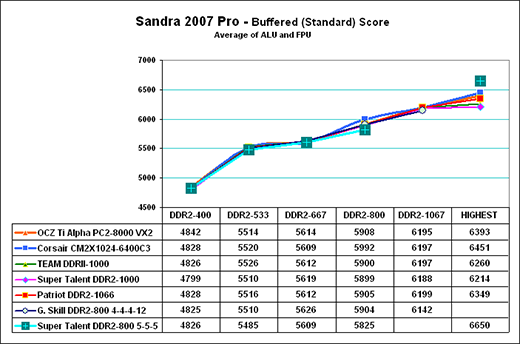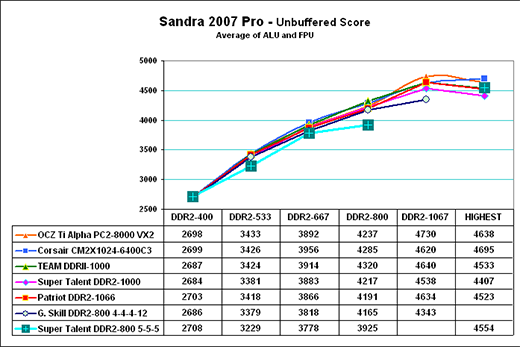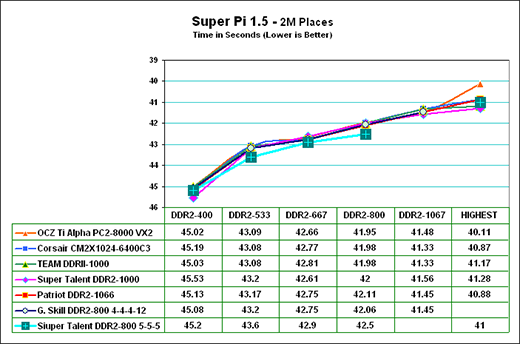Value DDR2-800 from Super Talent: Where Can You Go?
by Wesley Fink on November 29, 2006 12:05 AM EST- Posted in
- Memory
Memory Bandwidth Scaling
Memory bandwidth normally improves with increases in memory speed and reductions in memory timings. This is best illustrated using Performance Scaling charts instead of the bar charts for individual speeds that were used in past memory reviews.
Since the results for high-end memory were so close at all tested speeds, the scale range was reduced to better show the small differences in these memory benchmark results. Please keep this in mind when viewing the charts, since a normal zero scale would make performance differences appear much smaller than these expanded scale charts. Values for the tested memories are included below each chart for reference.
To evaluate memory bandwidth SiSoft Sandra 2007 Professional is used to provide a closer look at scaling for fast DDR2 memory.

The most widely reported Sandra score is the Standard or Buffered memory score. This benchmark takes into account the buffering schemes like MMX, SSE, SSE2, SSE3, and other buffering tools that are used to improve memory performance. Buffered bandwidth performance of the Super Talent memory was virtually the same as the previously tested high-end DDR2 memory at DDR2-800. The Super Talent could not reach DDR2-1067 with stability and topped out at DDR2-1000. Performance at DDR2-1000 cannot be directly compared to other top-end results since the system is modestly overclocked using a DDR2-889 ratio at a FSB setting of 300 where the other memories used a DDR2-1067 ratio.
The Buffered benchmark does not correlate well with real performance differences in games, so our memory bandwidth tests have always included an Unbuffered Sandra memory score. The Unbuffered result turns off the buffering schemes, and we have found the difference in Unbuffered results correlate well with real-world performance differences.

In Unbuffered tests the Super Talent mirrors the best memory tested to DDR2-800, but at a slightly lower performance due to the slower timings. There is no DDR2-1067 performance with the Super Talent and the highest stable speed, DDR2-1000, required a DDR2-889 memory ratio at a bus overclock to 300. It is worth pointing out, however, that memory bandwidth, both buffered and Unbuffered, continue to increase with memory speed.
We also compared results with Version 1.5 of Super Pi - comparing the time to calculate 2 million places of Pi at the different memory speeds. This benchmark measures pure number crunching.

Super Pi results continue to improve all the way to the highest speed that could be reached with stability with each memory. The second result that stands out is how very close the results with all the memories really are.. All four top-end memories perform very similarly. . The Super Talent drops off a bit at the top and bottom due to slightly slower timings in those ranges. The mid-range G. Skill performs similarly until DDR2-1067 where slower timings finally provide a penalty. The Super Talent DDR2-800 value memory drops off a bit at DDR2-800 due to slightly slower timings, but the performance is still remarkably close to the best we have tested. While performance is very close, Super Pi scaling charts continue to show the useful sensitivity of Super Pi as a measurement of memory performance
Memory bandwidth normally improves with increases in memory speed and reductions in memory timings. This is best illustrated using Performance Scaling charts instead of the bar charts for individual speeds that were used in past memory reviews.
Since the results for high-end memory were so close at all tested speeds, the scale range was reduced to better show the small differences in these memory benchmark results. Please keep this in mind when viewing the charts, since a normal zero scale would make performance differences appear much smaller than these expanded scale charts. Values for the tested memories are included below each chart for reference.
To evaluate memory bandwidth SiSoft Sandra 2007 Professional is used to provide a closer look at scaling for fast DDR2 memory.

The most widely reported Sandra score is the Standard or Buffered memory score. This benchmark takes into account the buffering schemes like MMX, SSE, SSE2, SSE3, and other buffering tools that are used to improve memory performance. Buffered bandwidth performance of the Super Talent memory was virtually the same as the previously tested high-end DDR2 memory at DDR2-800. The Super Talent could not reach DDR2-1067 with stability and topped out at DDR2-1000. Performance at DDR2-1000 cannot be directly compared to other top-end results since the system is modestly overclocked using a DDR2-889 ratio at a FSB setting of 300 where the other memories used a DDR2-1067 ratio.
The Buffered benchmark does not correlate well with real performance differences in games, so our memory bandwidth tests have always included an Unbuffered Sandra memory score. The Unbuffered result turns off the buffering schemes, and we have found the difference in Unbuffered results correlate well with real-world performance differences.

In Unbuffered tests the Super Talent mirrors the best memory tested to DDR2-800, but at a slightly lower performance due to the slower timings. There is no DDR2-1067 performance with the Super Talent and the highest stable speed, DDR2-1000, required a DDR2-889 memory ratio at a bus overclock to 300. It is worth pointing out, however, that memory bandwidth, both buffered and Unbuffered, continue to increase with memory speed.
We also compared results with Version 1.5 of Super Pi - comparing the time to calculate 2 million places of Pi at the different memory speeds. This benchmark measures pure number crunching.

Super Pi results continue to improve all the way to the highest speed that could be reached with stability with each memory. The second result that stands out is how very close the results with all the memories really are.. All four top-end memories perform very similarly. . The Super Talent drops off a bit at the top and bottom due to slightly slower timings in those ranges. The mid-range G. Skill performs similarly until DDR2-1067 where slower timings finally provide a penalty. The Super Talent DDR2-800 value memory drops off a bit at DDR2-800 due to slightly slower timings, but the performance is still remarkably close to the best we have tested. While performance is very close, Super Pi scaling charts continue to show the useful sensitivity of Super Pi as a measurement of memory performance










28 Comments
View All Comments
Wesley Fink - Wednesday, November 29, 2006 - link
Pretty is not good by itself, but pretty IS an indication that a company has the resources to compete in the market and that they are proud enough of their product to make it want to stand out.Our past experience has been that memory that is amateurishly packaged either improves in "pretty" and stays in the market, or dwindles away in the ugly packaging in which it was introduced.
peldor - Wednesday, November 29, 2006 - link
If pretty is an indication of something about a company then I'm worried about AnandTech. Those line graphs in this article are hideous, and the front page ain't too hot. At least that expanding Crossfire ad isn't running anymore.brshoemak - Wednesday, November 29, 2006 - link
this is a little OT but I sincerely hope their enthusiast memory is of a higher quality than their standard DDR memory.We bought around 30 sticks of Super Talent DDR memory and some Corsair ValueRam from a couple different distributors to build PC's with less than a year ago. So far, 16 (over half) of the Super Talent sticks have gone bad and every time I hear of a new PC problem it's almost always Super Talent memory inside.
If the enthusiast memory is better quality that's great, but due to my own personal experience I would be wary of their value-segment offerings. JMO
Xajel - Wednesday, November 29, 2006 - link
Users are AMD and Intel, how an Article like this be helpfull if it cover only less than half of the market ?? I hope to see three variants, Intel Core 2, Intel P4 & D and AMD's AM2 platform...Frumious1 - Wednesday, November 29, 2006 - link
In related news, reading comprehension is on the decline so things need to be pointed out with bold flashing text:Page 2:
DDR2 memory performance, in timings and required voltage, are equivalent on the AM2 and Core 2 Duo platforms. This was clearly illustrated in Conroe vs. AM2: Memory & Performance. However, the first generation of AM2 on-processor memory controller does not support any memory timings below 3, or memory speeds above DDR2-800, while both these features are supported on the Intel platform. Timings of 2 are available for RAS-to-CAS and RAS Precharge, and DDR2-1067 is a memory speed option on most Intel motherboards. The lack of extended memory timings and memory speeds makes it more difficult to test the newest high-speed DDR2 memories on an AM2 platform.
In other words, the memory timings and voltages you can get are the same on both platforms. Performance with AM2 while keeping CPU speed constant is going to improve slightly with more bandwidth just like on Core 2. Most people after high-end memory are going to overclock anyway, at which point it's just a matter of determining how high you can go with the various RAM.
Core 2 could use a 1:1 ratio and run with this RAM at up to 2000 FSB. Athlon AM2 could do "1:1" at up to DDR2-1000 as well, but there's no way the HyperTransport bus is going to run at 500 MHz base speed. So you can go with the DDR2-800 divider and get up to around 250 MHz HT speed (a 25% overclock), or you could drop to a lower divider like DDR2-667 and probably hit the limits of your motherboard. If not with the 667 setting then certainly with the DDR2-533 setting. Actual memory speeds on AM2 are a bit different then what you select anyway, depending on CPU, as the final RAM speed is derived from the CPU speed an not from the bus speed.
This is all beside the point, as the main thing to note is that this value RAM will work extremely well for all but the most demanding enthusiasts.
AndyKH - Wednesday, November 29, 2006 - link
As far as I understand, 533MHz DDR2 will theoretically max out the bandwidth on a 1067MHz FSB, as the memory interface is 128 bits, while FSB is 64 bits. Thus, the only reason that the faster memories perform better is that the timings are relative to the clock speed and will therefore get faster with increased memory clock speed. Is this correct?Wesley Fink - Wednesday, November 29, 2006 - link
This is partly true. Memory is Double Data Rate so DDR2-533 is the 1:1 match to a quad-pumped FSB base of 266 (1067). Memory ratios run the memory faster, and it performs better, while the base FSB clock remains the same. However, there is also overclcoking. At 1:1 or any given ratio, you can overclock the bus, which overclocks the memory in lock step at the settings you have chosen.With the nVidia 680i, for example, we reached a FSB of 2100 (525 quad-pumped), which is almost a 100% FSB overclock. In that case we had to drop memory ratios so the final memory speed would work with a 2100 bus.
Memory can be clocked higher by ratios or FSB overclocks, or a combination of both. This gives many options in squeezing the most performance from your memory and system.
Xajel - Wednesday, November 29, 2006 - link
the point is not about working and overclockablity or not, it's about compatibility as main concern, some mobos like MSI has hard compatibility with some DDR's like OCZ, some reports they can't even hit DDR2-800 speeds so how about overclocking ??some mobos, like those from ASUS ( mainly K8N's ) need BIOS update to make it possible to work with OCZ memories in DDR2-800 in Dual channel mode, a lot of users start there rigs with two stick on only one channel then do BIOS flash update and then rearrange the stick to enable DualChannel.
some guys need to upgrade but they don't know about compatibility issues they may have with such brand new memory !!
JarredWalton - Wednesday, November 29, 2006 - link
The major concern with compatibility almost always comes from default required voltages. Since this Super Talent requires 1.8V by default, it should work on any DDR2 platform that recognizes the DDR2-800 speed. I'm sure Wes has played with the RAM on more than one motherboard, so if he hasn't made comments about incompatibilities (and he actually mentions the benefits of the 1.8V requirement) then it's about as "safe" as you can get.Cali3350 - Wednesday, November 29, 2006 - link
When might this be available, and perhaps more inportantly if it already is does anyone know where? I cannot find it anywhere.